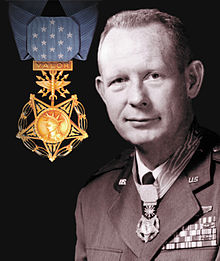Bernard F. Fisher
| Bernard Francis Fisher | |
|---|---|
 |
|
| Nickname(s) | Bernie |
| Born |
January 11, 1927 San Bernardino, California |
| Died | August 16, 2014 (aged 87) Boise, Idaho |
| Allegiance | United States of America |
| Service/branch |
Air National Guard US Air Force |
| Years of service | 1947 – 1950 (ANG) 1951 – 1974 (USAF) |
| Rank | Colonel |
| Unit | 1st Air Commando Squadron |
| Battles/wars | Vietnam War |
| Awards |
Medal of Honor Silver Star Distinguished Flying Cross Bronze Star Air Medal |
Bernard Francis "Bernie" Fisher (pronounced Bernerd) (January 11, 1927 – August 16, 2014) was a United States Air Force officer and a recipient of the U.S. military's highest decoration, the Medal of Honor. He was the first Air Force member to receive the medal in the Vietnam War.
Born in 1927 in San Bernardino, California, Fisher was raised and educated in Utah, calling Clearfield home. He served briefly in the Navy at the end of World War II, enrolled at Boise State Junior College in 1947, and transferred to the University of Utah in Salt Lake City in 1949. He was a member of The Church of Jesus Christ of Latter-day Saints.
From 1947 to 1950, Fisher was a member of the Air National Guard. Before he was able to complete his undergraduate degree at the University of Utah, he was commissioned into the Air Force in 1951. After pilot training, he served as a jet fighter pilot in the Air Defense Command until 1965, when he volunteered for duty in Vietnam. From July 1965 through June 1966, he flew 200 combat sorties in the A-1E/H "Spad" Skyraider as a member of the 1st Air Commando Squadron located at Pleiku Air Base, South Vietnam.
On March 10, 1966, he led a two-ship element of Skyraiders to the A Shau Valley to support troops in contact with the enemy. Six "Spads" were striking numerous emplacements when the A-1 piloted by Major D. W. "Jump" Myers was hit and forced to crash-land on the airstrip of a CIDG-Special Forces camp. Myers bellied in on the 2,500-foot runway and took cover behind an embankment on the edge of the strip while Fisher directed the rescue effort. Since the closest helicopter was 30 minutes away and the enemy was only 200 yards (180 m) from Myers, Fisher quickly decided to land his two-seat A-1E on the strip and pick up his friend. Under the cover provided by the other A-1s, he landed in the valley, taxied to Myer's position, and loaded the downed airman into the empty seat. Dodging shell holes and debris on the steel-planked runway, Fisher took off safely despite many hits on his aircraft by small-arms fire.
...
Wikipedia
